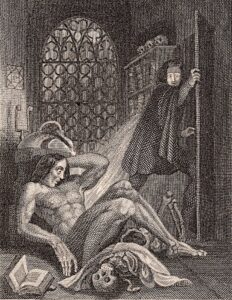 I’m delighted to welcome back to the blog historical fiction writer Annie Whitehead. Annie studied history under the eminent Medievalist Ann Williams. She is a member of the Royal Historical Society and an editor for English Historical Fiction Authors. She has written three award-winning novels set in Anglo-Saxon England, one of which was long-listed for the Historical Novel Society Indie Book of the Year 2016, and her full-length nonfiction book, Mercia: The Rise and Fall of a Kingdom is published by Amberley Books.
I’m delighted to welcome back to the blog historical fiction writer Annie Whitehead. Annie studied history under the eminent Medievalist Ann Williams. She is a member of the Royal Historical Society and an editor for English Historical Fiction Authors. She has written three award-winning novels set in Anglo-Saxon England, one of which was long-listed for the Historical Novel Society Indie Book of the Year 2016, and her full-length nonfiction book, Mercia: The Rise and Fall of a Kingdom is published by Amberley Books.
Annie has contributed to fiction and nonfiction anthologies and written for various magazines, including winning the New Writer Magazine Prose Competition. She was the winner of the inaugural Historical Writers’ Association/Dorothy Dunnett Prize 2017. Recently she has been a judge for that same competition, and for the HNS Short Story Competition. Women of Power in Anglo-Saxon England was published by Pen & Sword Books in June 2020.
Speaking of anthologies, we’ll both be contributing to a collection of historical stories about betrayal due out in November. Exciting stuff!
Over to Annie to tell us about putting together characters…
Lately I’ve been working on a piece of short fiction for an upcoming anthology. I decided that my piece would involve some characters from my second novel, Alvar the Kingmaker. Since my fiction up until now has centred around real historical figures, it was easy enough to look back at the years before the book begins to find out what those people were up to before they sashayed onto the pages of that novel.
And there was certainly a lot of recorded drama: people on the make, banishment, a couple of rather untimely, or perhaps we might say convenient, deaths. Factions, infighting, envy: it’s all there.
I began plotting my story. But then I found that certain figures, whilst they certainly existed and played a part in the history, were actually getting in the way of the story. I suppose that’s always the way with historical fiction. Just because stuff happened, we shouldn’t include it if it doesn’t suit our narrative or help the plot to progress. Likewise, just because people were at a particular place at a certain time, we shouldn’t include them if their presence adds nothing to the story.
The main problem, though, was that one of my characters, Dunstan, seemed to be a different man altogether from the one I’d portrayed in the novel. It was as if I’d looked at this different portion of history and written a separate story about it. What I needed to do was remember the character I’d portrayed in the novel, and work backwards. Because yes, it is possible to write about these earlier years, which involved the same people, and end up sketching a completely different man from the one presented in the novel.
Each author will have a different idea about a character. There are many different King Arthurs out there in fiction and yet each one is really a different man. And I, researching the same figure in a slightly different period, had very nearly written a completely separate character. Which just goes to prove how much the novelist moulds the people into their own distinctive shape.
There are different types of historical fiction, and many authors write more than one kind. Some put entirely fictional characters into historical settings, while others fictionalise the lives of real people. So you either have a Forest Gump situation, where a made-up character interacts with real figures, or a set of completely imaginary people playing out their drama against the backdrop of a real historical context, as they do in Les Misérables. Or you have an author’s take on the lives of people from history, such as Elizabeth Chadwick’s series about William Marshal. Thus far, my fiction has fallen into that latter category.
In all of those examples, though, it is crucial to remember that those characters, real or otherwise, must be moulded into people. People who have distinct psychological characteristics, logical personalities, and a back story, even if the reader never sees it.
We know the facts, but we have to make them fit with the character we’ve designed. We have to play God, and make the character a real person, and give reasons for why they act like they do. We must take the time to get to know our character, not the historical figure, in order to make it plausible. When we write historical fiction we must ensure that we tell the human story and bring our characters alive.
We must do more than simply thinking, “Why did s/he do that? Or act in a particular way?” because that’s still an essay, rather than a story. We really have to dig deeper and ‘see’ the person with all their human attributes; their flaws, frailties, and strengths.
So, my task was to remind myself of the man I’d written about, and make him behave in his younger days in a way that would make sense for anyone who has read, or will read, the novel.
So that when people read both, which I hope they will, they will recognise him as a person, the historical figure being almost incidental.
As Dorothy Dunnett said, “History is all very well, but it’s just the showcase. It’s the arena in which your character will perform.”
Find out more about Annie and her books
Website: https://anniewhiteheadauthor.co.uk/
Blog: https://anniewhitehead2.blogspot.com/
Twitter: https://twitter.com/AnnieWHistory @AnnieWHistory
Facebook: https://www.facebook.com/anniewhiteheadauthor/
Read Annie’s story of power and change – Alvar the Kingmaker
 The king is caught in bed with his wife and her mother.
The king is caught in bed with his wife and her mother.
Alvar, earl of Mercia, having helped King Edgar to secure the throne, must fight to clear the queen’s name, bring the country back from the brink of civil war, and stabilise the monarchy for Edgar’s son, Æthelred the Unready.
He does this at great personal cost, and his enemies will stop at little: Abbot Dunstan, banished, recalled, and in no mood to forgive; Bishop Oswald, the ambitious foreigner who will let nothing stand in his way.
They must not discover Alvar’s secret love for the wife of his deputy. Alvar must keep her safe, whilst serving and protecting the queen, who is in love with him, but who harbours a dark secret of her own…
Buy the ebook here: Amazon Kindle and the paperback here.
Alison Morton is the author of Roma Nova thrillers – INCEPTIO, PERFIDITAS, SUCCESSIO, AURELIA, INSURRECTIO and RETALIO. CARINA, a novella, and ROMA NOVA EXTRA, a collection of short stories, are now available. Audiobooks are available for four of the series. NEXUS, an Aurelia Mitela novella, is now out.
Find out more about Roma Nova, its origins, stories and heroines… Download ‘Welcome to Roma Nova’, a FREE eBook, as a thank you gift when you sign up to Alison’s monthly email newsletter. You’ll also be first to know about Roma Nova news and book progress before everybody else, and take part in giveaways.















Leave a Reply